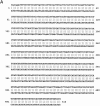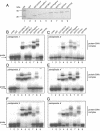Pentaprobe: a comprehensive sequence for the one-step detection of DNA-binding activities
- PMID: 14530457
- PMCID: PMC219492
- DOI: 10.1093/nar/gng124
Pentaprobe: a comprehensive sequence for the one-step detection of DNA-binding activities
Abstract
The rapid increase in the number of novel proteins identified in genome projects necessitates simple and rapid methods for assigning function. We describe a strategy for determining whether novel proteins possess typical sequence-specific DNA-binding activity. Many proteins bind recognition sequences of 5 bp or less. Given that there are 4(5) possible 5 bp sites, one might expect the length of sequence required to cover all possibilities would be 4(5) x 5 or 5120 nt. But by allowing overlaps, utilising both strands and using a computer algorithm to generate the minimum sequence, we find the length required is only 516 base pairs. We generated this sequence as six overlapping double-stranded oligonucleotides, termed pentaprobe, and used it in gel retardation experiments to assess DNA binding by both known and putative DNA-binding proteins from several protein families. We have confirmed binding by the zinc finger proteins BKLF, Eos and Pegasus, the Ets domain protein PU.1 and the treble clef N- and C-terminal fingers of GATA-1. We also showed that the N-terminal zinc finger domain of FOG-1 does not behave as a typical DNA-binding domain. Our results suggest that pentaprobe, and related sequences such as hexaprobe, represent useful tools for probing protein function.
Figures








References
-
- Perdomo J., Holmes,M., Chong,B. and Crossley,M. (2000) Eos and pegasus, two members of the Ikaros family of proteins with distinct DNA binding activities. J. Biol. Chem., 275, 38347–38354. - PubMed
-
- Newton A., Mackay,J. and Crossley,M. (2001) The N-terminal zinc finger of the erythroid transcription factor GATA-1 binds GATC motifs in DNA. J. Biol. Chem., 276, 35794–35801. - PubMed
-
- Maniatis T., Fritsch,E.F. and Sambrook,J. (1982) Molecular Cloning: A Laboratory Manual. Cold Spring Harbor Laboratory Press, Cold Spring Harbor, NY.
Publication types
MeSH terms
Substances
LinkOut - more resources
Full Text Sources
Other Literature Sources
Research Materials

